
Parmelia is a genus of medium to large foliose lichens. It has a global distribution, extending from the Arctic to the Antarctic continent but concentrated in temperate regions. There are about 40 species in Parmelia. In recent decades, the once large genus Parmelia has been divided into a number of smaller genera according to thallus morphology and phylogenetic relatedness.
Irwin M. Brodo is an emeritus scientist at the Canadian Museum of Nature, in Ottawa, Ontario, Canada. He is an authority on the identification and biology of lichens. Irwin Brodo was honored in 1994 with an Acharius Medal presented to him by the International Association for Lichenology.

Ramalina is a genus of greenish fruticose lichens that grow in the form of flattened, strap-like branches. Members of the genus are commonly called strap lichens or cartilage lichens. Apothecia are lecanorine.
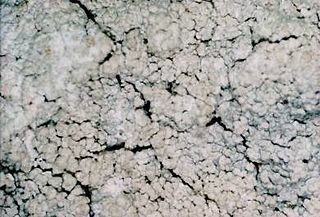
Lepraria is a genus of leprose crustose lichens that grows on its substrate like patches of granular, caked up, mealy dust grains. Members of the genus are commonly called dust lichens. The main vegetative body (thallus) is made of patches of soredia. There are no known mechanisms for sexual reproduction, yet members of the genus continue to speciate. Some species can form marginal lobes and appear squamulose.

Anzia is a genus of foliose lichens known as black-foam lichens in the large family Parmeliaceae. It was formerly included in the monogeneric family Anziaceae, but this has since been subsumed into the Parmeliaceae.

Cornicularia is a genus of lichenised ascomycetes in the large family Parmeliaceae. It is a monotypic genus, with a single currently accepted species, the saxicolous lichen Cornicularia normoerica. This species has an erect caespitose growth form, and is sometimes referred to as the brittle lichen.
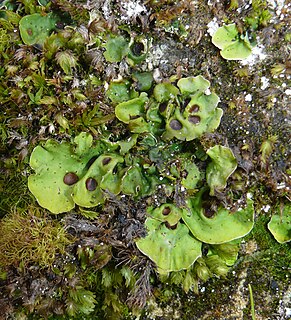
Solorina is a genus of 10 species of lichenized fungi in the family Peltigeraceae. The genus was first described by the Swedish botanist Erik Acharius in 1808. Members of the genus are commonly called socket lichens.

Pilophorus acicularis, commonly known as the nail lichen or the devil's matchstick lichen, is a species of matchstick lichen in the family Cladoniaceae.

Foliose lichen is one of the morphological classes of lichens, which are complex organisms that arise from the symbiotic relationship between fungi and a photosynthetic partner, typically algae. This partnership allows lichen to live in diverse climates that can range from cold, dry mountains to wet, warm valleys. Lichens develop quite slowly with recorded growth rates of 0.01–27mm/year depending on the species. Their lifespan averages between 30 and 60 years.
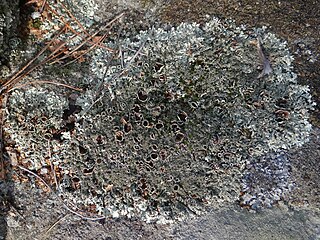
Xanthoparmelia conspersa, commonly known as the peppered rock-shield, is a foliose lichen and the type species of genus Xanthoparmelia. It is widely distributed in temperate zones, and has been recorded from Japan, Europe, Africa, North America, and South America.

Parmelia saxatilis, commonly known as the salted shield lichen or crottle, is a species of foliose lichen in the family Parmeliaceae. Several morphologically similar species, formerly lumped together, are now distinguished by their DNA.

Niebla homalea is a species of fruticose lichen that grows on rocks in foggy areas along the Pacific Coast of North America, from Mendocino County, California south to Bahía de San Quintín on the main peninsula of Baja California, with an isolated occurrence further south on vertical rock faces above Punta Camachos, and other occurrences in the Channel Islands and on Guadalupe Island. The epithet homalea, given by Acharius, suggests it was in regard to the branches appearing flattened.
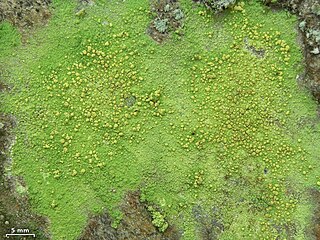
Psilolechia lucida is a species of saxicolous lichen in the family Psilolechiaceae. It is widely distributed through the world, where it grows on natural and artificial rocky substrates in the shade, often in sheltered underhangs. It forms a greenish crust on the surface of its substrate.

Pyxine sorediata, commonly known as mustard lichen, is a widely distributed species of foliose lichen in the family Caliciaceae. It has a subtropical to warm temperate distribution, and grows on bark, rocks, and moss as substrates. Pyxine sorediata has been reported from regions of North America, Europe, Africa, Asia, and Australasia.
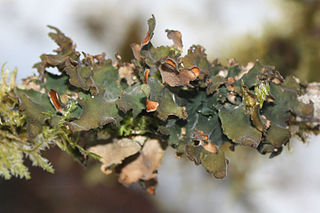
Nephroma resupinatum, commonly known as the pimpled kidney lichen, is a species of foliose lichen in the family Peltigeraceae. It was first described by Carl Linnaeus in his 1753 work Species Plantarum as Lichen resupinatus. Erik Acharius transferred it to the genus Nephroma in 1810.

Calicium trabinellum, commonly known as the yellow-collar stubble lichen, is a widespread species of pin lichen in the family Caliciaceae. It was first described by Swedish lichenologist Erik Acharius in 1803 as Calicium xylonellum ß trabinellum. He made the new combination Calicium trabinellum in a later chapter of the same publication.

Umbilicaria hyperborea, commonly known as blistered rock tripe, is a species of foliose lichen in the family Umbilicariaceae. It is widely distributed in arctic and alpine regions.
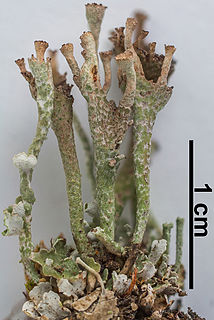
Cladonia cervicornis is a species of cup lichen in the family Cladoniaceae. It was first described by Swedish lichenologist Erik Acharius in 1799 as Lichen cervicornis. Julius von Flotow transferred it to the genus Cladonia in 1849. In North America, it is colloquially known as the ladder lichen or elk's-horn cup lichen.

Cladonia ecmocyna or the frosted cup lichen is a species of fruticose, cup lichen in the family Cladoniaceae. It was first scientifically described as a new species in 1810 by Swedish lichenologist Erik Acharius as Cenomyce ecmocyna. British botanist William Allport Leighton transferred it to the genus Cladonia in 1866. In North America, it is known colloquially as the "frosted cladonia".

Gowardia nigricans, commonly known as the gray hair lichen or gray witch's hair, is a species of fruticose lichen in the family Parmeliaceae.



















